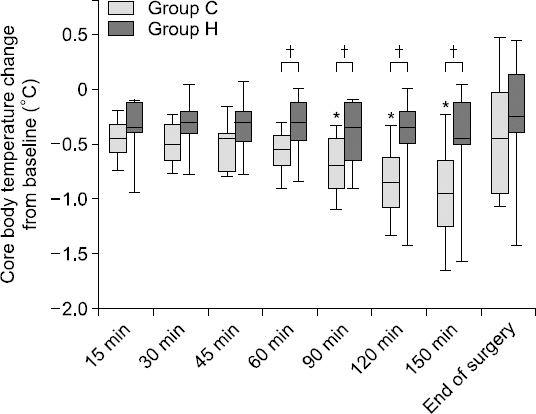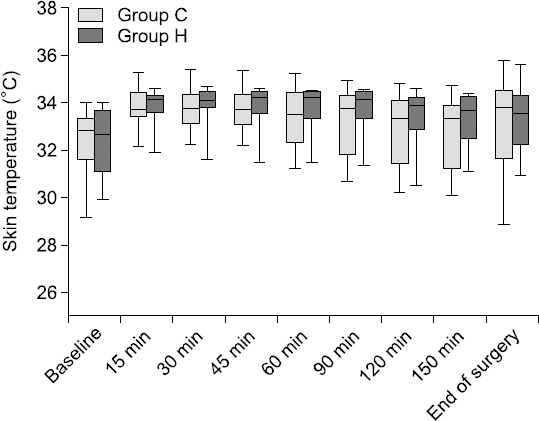Anesth Pain Med.
2016 Apr;11(2):211-216. 10.17085/apm.2016.11.2.211.
Effect of electrically heated humidifier on intraoperative core body temperature decrease in elderly patients: a prospective observational study
- Affiliations
-
- 1Department of Anesthesiolgoy and Pain Medicine, Asan Medical Center, University of Ulsan College of Medicine, Seoul, Korea. jhhwang@amc.seoul.kr
- 2Department of Anesthesiology and Pain Medicine, Seoul National University Hospital, Seoul, Korea.
- KMID: 2358488
- DOI: http://doi.org/10.17085/apm.2016.11.2.211
Abstract
- BACKGROUND
Core body temperature (TC) can decrease during general anesthesia. Particularly in elderly patients, more aggressive strategies to prevent intraoperative hypothermia may be required. Here, we investigated the effect of a heated humidifier on intraoperative TC decrease in the elderly.
METHODS
Twenty-four elderly patients were randomly assigned into two groups: those who used a heated humidifier (group H) and those who used a conventional ventilator circuit with a heat moisture exchanger (group C). TC was measured continuously at the esophagus at several time-points during surgery.
RESULTS
In group C, TC significantly decreased 90 minutes after skin incision (P < 0.001), while significant differences were not noted in group H during surgery. Comparing the two groups, TC decreased more in group C than in group H at 60, 90, 120, and 150 minutes after skin incision (group C vs. group H: -0.6℃ vs. -0.3℃, P = 0.025; -0.7℃ vs. -0.4℃, P = 0.012; -0.9℃ vs. -0.4℃, P = 0.006; and -1.0℃ vs. -0.5℃, P = 0.013, respectively). There were no significant differences between the two groups for any other parameters.
CONCLUSIONS
A heated humidifier is more effective in preventing intraoperative TC decrease in elderly patients than a heat moisture exchanger. However, further studies with a larger population are required to substantiate its clinical use.
MeSH Terms
Figure
Cited by 2 articles
-
The efficacy of warming blanket on reducing intraoperative hypothermia in patients undergoing transurethral resection of bladder tumor under general anesthesia
Seongsoo Hong, Byung Hoon Yoo, Kye-Min Kim, Mun-Cheol Kim, Jun Heum Yon, and Sangseok Lee
Anesth Pain Med. 2016;11(4):404-409. doi: 10.17085/apm.2016.11.4.404.Anesthetic management of geriatric patients
Byung-Gun Lim, Il-Ok Lee
Korean J Anesthesiol. 2020;73(1):8-29. doi: 10.4097/kja.19391.
Reference
-
1. Sessler DI. Temperature monitoring and perioperative thermoregulation. Anesthesiology. 2008; 109:318–38. DOI: 10.1097/ALN.0b013e31817f6d76. PMID: 18648241. PMCID: PMC2614355.
Article2. Sessler DI. Mild perioperative hypothermia. N Engl J Med. 1997; 336:1730–7. DOI: 10.1056/NEJM199706123362407. PMID: 9180091.
Article3. Cereda M, Maccioli GA. Intraoperative temperature monitoring. Int Anesthesiol Clin. 2004; 42:41–54. DOI: 10.1097/00004311-200404220-00005. PMID: 15087740.
Article4. Stone DR, Downs JB, Paul WL, Perkins HM. Adult body temperature and heated humidification of anesthetic gases during general anesthesia. Anesth Analg. 1981; 60:736–41. DOI: 10.1213/00000539-198110000-00008. PMID: 7197477.
Article5. Sessler DI. Complications and treatment of mild hypothermia. Anesthesiology. 2001; 95:531–43. DOI: 10.1097/00000542-200108000-00040. PMID: 11506130.
Article6. Frank SM, Fleisher LA, Breslow MJ, Higgins MS, Olson KF, Kelly S, et al. Perioperative maintenance of normothermia reduces the incidence of morbid cardiac events. A randomized clinical trial. JAMA. 1997; 277:1127–34. DOI: 10.1001/jama.277.14.1127. PMID: 9087467.
Article7. Degroot DW, Kenney WL. Impaired defense of core temperature in aged humans during mild cold stress. Am J Physiol Regul Integr Comp Physiol. 2007; 292:R103–8. DOI: 10.1152/ajpregu.00074.2006. PMID: 17197640.
Article8. Macario A, Dexter F. What are the most important risk factors for a patient’s developing intraoperative hypothermia? Anesth Analg. 2002; 94:215–20. DOI: 10.1097/00000539-200201000-00042. PMID: 11772832.
Article9. Jin F, Chung F. Minimizing perioperative adverse events in the elderly. Br J Anaesth. 2001; 87:608–24. DOI: 10.1093/bja/87.4.608. PMID: 11878732.
Article10. Hasegawa K, Negishi C, Nakagawa F, Ozaki M. Core temperatures during major abdominal surgery in patients warmed with new circulating-water garment, forced-air warming, or carbon-fiber resistive-heating system. J Anesth. 2012; 26:168–73. DOI: 10.1007/s00540-011-1306-1. PMID: 22189652. PMCID: PMC3328673.
Article11. Taguchi A, Ratnaraj J, Kabon B, Sharma N, Lenhardt R, Sessler DI, et al. Effects of a circulating-water garment and forced-air warming on body heat content and core temperature. Anesthesiology. 2004; 100:1058–64. DOI: 10.1097/00000542-200405000-00005. PMID: 15114200. PMCID: PMC1409744.
Article12. Lee HK, Jang YH, Choi KW, Lee JH. The effect of electrically heated humidifier on the body temperature and blood loss in spinal surgery under general anesthesia. Korean J Anesthesiol. 2011; 61:112–6. DOI: 10.4097/kjae.2011.61.2.112. PMID: 21927679. PMCID: PMC3167128.
Article13. Yam PC, Carli F. Maintenance of body temperature in elderly patients who have joint replacement surgery. A comparison between the heat and moisture exchanger and heated humidifier. Anaesthesia. 1990; 45:563–5. DOI: 10.1111/j.1365-2044.1990.tb14832.x.
Article14. Shanks CA. Heat balance during surgery involving body cavities. Anaesth Intensive Care. 1975; 3:114–7. PMID: 1155752.
Article15. Han SB, Gwak MS, Choi SJ, Kim MH, Ko JS, Kim GS, et al. Effect of active airway warming on body core temperature during adult liver transplantation. Transplant Proc. 2013; 45:251–4. DOI: 10.1016/j.transproceed.2012.05.088. PMID: 23375310.
Article16. Johansson A, Lundberg D, Luttropp HH. The effect of heat and moisture exchanger on humidity and body temperature in a low-flow anaesthesia system. Acta Anaesthesiol Scand. 2003; 47:564–8. DOI: 10.1034/j.1399-6576.2003.00108.x. PMID: 12699514.
Article17. Graff TD, Benson DW. Systemic and pulmonary changes with inhaled humid atmospheres: clinical application. Anesthesiology. 1969; 30:199–207. DOI: 10.1097/00000542-196902000-00017.18. Matsukawa T, Sessler DI, Sessler AM, Schroeder M, Ozaki M, Kurz A, et al. Heat flow and distribution during induction of general anesthesia. Anesthesiology. 1995; 82:662–73. DOI: 10.1097/00000542-199503000-00008. PMID: 7879935.
Article19. Hynson JM, Sessler DI. Intraoperative warming therapies: a comparison of three devices. J Clin Anesth. 1992; 4:194–9. DOI: 10.1016/0952-8180(92)90064-8.
Article20. Díaz M, Becker DE. Thermoregulation: physiological and clinical considerations during sedation and general anesthesia. Anesth Prog. 2010; 57:25–32. DOI: 10.2344/0003-3006-57.1.25. PMID: 20331336. PMCID: PMC2844235.
Article21. Sessler DI. Perioperative heat balance. Anesthesiology. 2000; 92:578–96. DOI: 10.1097/00000542-200002000-00042. PMID: 10691247.
Article22. Hart SR, Bordes B, Hart J, Corsino D, Harmon D. Unintended perioperative hypothermia. Ochsner J. 2011; 11:259–70. PMCID: PMC3179201.23. Kurz A, Plattner O, Sessler DI, Huemer G, Redl G, Lackner F. The threshold for thermoregulatory vasoconstriction during nitrous oxide/isoflurane anesthesia is lower in elderly than in young patients. Anesthesiology. 1993; 79:465–9. DOI: 10.1097/00000542-199309000-00008. PMID: 8363070.
Article24. Winkler M, Akça O, Birkenberg B, Hetz H, Scheck T, Arkiliç CF, et al. Aggressive warming reduces blood loss during hip arthroplasty. Anesth Analg. 2000; 91:978–84. DOI: 10.1097/00000539-200010000-00039. PMID: 11004060.
Article25. Schmied H, Kurz A, Sessler DI, Kozek S, Reiter A. Mild hypothermia increases blood loss and transfusion requirements during total hip arthroplasty. Lancet. 1996; 347:289–92. DOI: 10.1016/S0140-6736(96)90466-3.
Article26. Falk B, Bar-Or O, Smolander J, Frost G. Response to rest and exercise in the cold: effects of age and aerobic fitness. J Appl Physiol (1985). 1994; 76:72–8.
Article27. Horvath SM, Radcliffe CE, Hutt BK, Spurr GB. Metabolic responses of old people to a cold environment. J Appl Physiol. 1955; 8:145–8.
Article28. An TH, Yang JW. Effects of PEEP on the thermoregulatory responses during TIVA in patients undergoing tympanoplasty. Korean J Anesthesiol. 2011; 61:302–7. DOI: 10.4097/kjae.2011.61.4.302. PMID: 22110883. PMCID: PMC3219776.
Article29. Kim E, Lee SY, Lim YJ, Choi JY, Jeon YT, Hwang JW, et al. Effect of a new heated and humidified breathing circuit with a fluid-warming device on intraoperative core temperature: a prospective randomized study. J Anesth. 2015; 29:499–507. DOI: 10.1007/s00540-015-1994-z. PMID: 25771760.
Article
- Full Text Links
- Actions
-
Cited
- CITED
-
- Close
- Share
- Similar articles
-
- The effect of warmed inspired gases on body temperature during arthroscopic shoulder surgery under general anesthesia
- The effect of electrically heated humidifier on the body temperature and blood loss in spinal surgery under general anesthesia
- Heated wire humidification circuit attenuates the decrease of core temperature during general anesthesia in patients undergoing arthroscopic hip surgery
- A comparative evaluation of humidifier with heated wire breathing circuit under general anesthesia
- Effect of active airway warming with a heated-humidified breathing circuit on core body temperature in patients under general anesthesia: a systematic review and meta-analysis with trial sequential analysis



